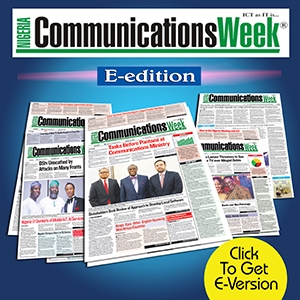Telecom
Samsung Leads Again With Biometric Scanner-Enabled Galaxy S5

Samsung Electronics’, the world’s largest maker of mobile handsets, has taken the lid off its highly anticipated Galaxy S5 smartphone, adding a new Galaxy device to its range of products in this category.
The fifth generation of the Galaxy S series was unveiled at an ‘Unpacked’ event during the 2014 edition of the Mobile World Congress in Barcelona and will be available for purchase in 150 countries, including Nigeria, on April 11.
Powered by a 2.5GHz quad-core processor, the Galaxy S5 sports a 5.1-inch super AMOLED display, making it slightly larger than its predecessor, the Galaxy S4.
The device also boasts an upgraded 16-megapixel camera, new fitness tracking features, a heart rate scanner and is dust and water resistant.
The highlight of the Galaxy S5 is a new fingerprint sensor, which is integrated with the device’s home button.
The finger scanner will provide consumers with a safe, biometric screen-locking feature and also make their mobile payment experience more secure.
Speaking at the unveiling of the device, Mr. Emmanouil Revmatas, director, Hand Held Products, Samsung Electronics West Africa, said the new Galaxy S5 offers consumers a refined experience with the added advantage of innovation on essential features for everyday use.
“With the Galaxy S5, Samsung is going back to basics to focus on delivering the capabilities that matter most to consumers. A great number of innovations have been injected into the device towards delivering new value to enhance their lives and also provide them with the ultimate communication experience. The Galaxy S5 represents an iconic design with essential and useful features to focus on delivering the ultimate smartphone in the market today through people-inspired innovation,” he said.
He added that the device will set the benchmark for how a smartphone can be integrated into daily life.
The new Galaxy S5 features a perforated pattern on the back cover creating a stylish and modern look. It comes in an array of colors, including Charcoal Black, Shimmery White, Electric Blue and Copper Gold. The device is expected to become the best-selling smartphone in the world once it goes on sale in April.
Samsung also expanded its industry-leading wearable device line with Samsung Gear Fit, a breakthrough and futuristic fitness tracker that offers the convenience of Samsung Gear technology with comprehensive fitness tools that empower consumers to stay physically active without sacrificing personal style or mobile connectivity.
The wrist-worn device incorporates a built-in heart rate monitor and a lightweight swappable strap, alongside its signature curved AMOLED screen. The Gear Fit will also be available globally from April.
Speaking of the Gear Fit, Revmatas said: “Samsung understands that the next generation of wearable mobile solutions must directly reflect the diverse interests and needs of consumers.
In response, our Gear product portfolio continues to expand with unique devices for a wide range of lifestyles, including the new Gear Fit, which is designed to help consumers live fit and active lives without forfeiting their ability to stay connected on the go.”
Samsung Electronics Co. Limited is a global leader in technology, opening new possibilities for people everywhere.
Through relentless innovation and discovery, Samsung is transforming the worlds of televisions, smartphones, personal computers, printers, cameras, home appliances, LTE systems, medical devices, semiconductors and LED solutions.
The company employs 236,000 people across 79 countries with annual sales of $187.8 billion.
Telecom
Airtel Money Africa Partners pawaPay for Seamless International Remittances Across Africa

Airtel Money Africa, Airtel Africa’s mobile money arm, announced an extended partnership with Africa’s largest mobile money payment service provider (PSP) pawaPay to enable seamless cross-border payments for licensed International Money Transfer Operators (IMTOs) across seven key Airtel Africa markets.

This collaboration officially launches pawaPay’s service for inbound remittances into Uganda, Rwanda, Zambia, Malawi, Gabon, Congo Brazzaville, and Tanzania. The partnership allows IMTOs to efficiently deliver funds globally directly to recipients’ more than 161 million Airtel Money customers wallets, leveraging pawaPay’s renowned reliability, scalability, and 99.9% platform uptime.
Building on five years of trusted collaboration in domestic mobile money, this expansion strengthens and simplifies Airtel Money Africa’s backend processes, using pawaPay’s robust payment service provider infrastructure, which processes over four million transactions daily.
Airtel Money Africa CEO, Ian Ferrao, said: “We’re pleased to expand our partnership with pawaPay to advance international remittances across Africa. Their proven reliability and commitment to African consumers make them an ideal partner. This integration empowers International Money Transfer Operators to securely connect with Airtel Money’s growing footprint, delivering real-time payments that support financial inclusion and economic growth.”
pawaPay CEO, Nikolai Barnwell, said: “Our mission is to simplify payments for businesses in Africa, and remittances are pivotal. Deepening our relationship with Airtel Money allows International Money Transfer Operators to leverage our world-class infrastructure for seamless cross-border payments.”
Remittances remain critical for millions of Africans, enabling family support, entrepreneurship, and financial inclusion. This partnership ensures secure, instant mobile wallet transactions, key to advancing Africa’s digital economy. pawaPay will extend this capability to additional Airtel Money Africa markets in coming months.
Telecom
Rubrik Joins Forces with Sophos to Reinvent M365 Recovery

Rubrik, the cybersecurity company, and Sophos, a global leader of innovative security solutions for defeating cyberattacks, have announced a strategic partnership to provide Sophos M365 Backup and Recovery Powered by Rubrik.

This marks the first Managed Detection and Response (MDR)-optimized Microsoft 365 backup and recovery solution fully integrated into Sophos Central, Sophos’ security operations platform.
Designed to support IT and cybersecurity teams, the new offering will provide a unified global platform to enhance cyber resilience against ransomware, account compromise, insider threats, and data loss in SharePoint, Exchange, OneDrive, and Teams.
“We are reshaping what it means to stay operational in a world shaped by constant digital disruption,” said Joe Levy, CEO, Sophos. “This is the future of cyber resilience: an intelligent, adaptive partnership that ensures organizations remain secure, responsive, and uninterrupted. By combining Sophos’ prevention-first approach with Rubrik’s unwavering recovery capabilities, we empower businesses to withstand attacks and maintain continuity, even under pressure.”
Sophos will offer a powerful new add-on solution for its more than 75,000 MDR and XDR customers, enabling fast, secure recovery of critical Microsoft 365 data in the event of accidental deletion or malicious compromise.
This solution integrates Rubrik’s industry-leading SaaS-based protection directly into the trusted Sophos Central platform, giving organizations the flexibility to enhance their existing security operations with robust data recovery capabilities.
The Sophos Central platform integrates over 350 different telemetry sources across endpoint, cloud, network, identity, email and business applications. The platform leverages deep learning, custom LLMs, and frontier models to detect and respond to threats across the entire attack surface, enhancing defense effectiveness.
“The reality of today’s threat landscape demands a holistic approach to cyber resilience,” said Bipul Sinha, CEO, Chairman, and Co-founder of Rubrik. “With AI-enabled attacks and sophisticated breaches on the rise, organizations need more than just prevention; they need the ability to recover rapidly and reliably. Our partnership with Sophos delivers this critical capability directly within a platform security teams already use and trust, raising the bar for Microsoft 365 resilience.”
The Evolving Threat Landscape
According to The State of Ransomware report by Sophos, nearly half of organizations impacted by ransomware chose to pay the ransom to recover their data. Despite this, only 54% of affected companies relied on backups for data restoration, highlighting a continued gap in effective cyber resilience practices.
Recent research highlights the urgent need for robust Microsoft 365 data protection: 60% of Microsoft 365 tenants have experienced account takeovers, a frequent launchpad for lateral movement within an organization, and 81% have encountered email compromise.
When global admin credentials are compromised, attackers can manipulate retention settings and permanently delete critical business data.
Existing tools were not designed for comprehensive, large-scale recovery, which requires speed, granularity, and reliability for rapid restoration.
Sophos MDR and XDR customers will benefit from:
- Secure, immutable backups: Rubrik will isolate Microsoft 365 backups with air-gapped storage, WORM locks, and customer-held encryption keys. Multifactor authentication and data lock prevent tampering, even with compromised credentials.
- Fast, flexible recovery: Customers will be able to restore Microsoft 365 emails, OneDrives, SharePoint sites, Teams channels, and more to original or alternate users, including inactive accounts.
- Automated protection: Rubrik will automatically discover Microsoft 365 users, sites, and mailboxes, applies Entra ID-based policies, and supports delegated admin – all integrated with Sophos Central to reduce manual effort.
- Unified experience: Microsoft 365 protection and security operations will be managed via Sophos Central with no extra tools.
Rubrik and Sophos’ shared commitment to helping organizations operate with confidence in the face of risk, will provide Sophos customers and partners with a powerful solution to recover with speed and precision when threats inevitably break through.
This offering will be available through Sophos’ channel partner network in the coming months.
Telecom
MTN Nigeria Rolls Out Network-as-a-Service and Signs First MVNO to Drive Industry Efficiency

MTN Nigeria is deepening its role as an industry enabler with the launch of its Network-as-a-Service (NaaS) platform and the signing of its first Mobile Virtual Network Operator (MVNO) agreement, Chief Financial Officer Modupe Kadri revealed on Monday.

Speaking in an exclusive Channels TV interview, Kadri confirmed that MTN has opened its network to T2 (formerly 9Mobile) under the NaaS framework approved by the Nigerian Communications Commission (NCC). This allows T2 subscribers to roam seamlessly on MTN’s infrastructure while retaining their own customer relationships and branding.
“Network-as-a-Service is a platform where MNOs can roam within the NCC framework on MTN’s network,” Kadri explained. “It makes the industry more efficient in the utilisation of scarce resources.”
Kadri also announced MTN’s first MVNO partnership, with the virtual operator set to go live soon. MVNOs lease network capacity from established mobile operators, enabling them to offer services without investing in costly infrastructure.
These initiatives align with NCC’s push for infrastructure sharing to boost sector efficiency and coverage. By providing network access to smaller players, MTN is positioning itself as a critical enabler of market expansion.
The Nigerian telecom industry, valued at $10.8 billion, now reaches 169 million active phone lines and over 142 million internet subscribers. While competition remains intense, the trend toward infrastructure sharing is expected to lower barriers to entry for new service providers, increase service quality, and expand access in underserved areas.
“As MTN, we are here to help the industry survive,” Kadri said. “It makes it much easier when you see other operators willing to come on and provide quality services to Nigerians, which we all deserve.”
Industry analysts view the move as a strategic diversification for MTN. With voice revenues plateauing and data driving growth, shared network models offer new revenue streams and a hedge against market saturation.
MTN’s investments in NaaS and MVNO partnerships are part of its broader transformation strategy, which also includes cost optimisation, forex risk reduction, and targeted capital expenditure to strengthen network quality.

 News1 day ago
News1 day agoGoogle Hit by AI-driven Cyber Attack

 General News1 day ago
General News1 day agoKuwait Busts Nigerian Cybercrime Ring Targeting Telecom Tower, Banks

 E-Business1 day ago
E-Business1 day agoZequence Digital Boss Calls for Strong IP Laws Enforcement, to Protect Nigeria’s Software Sector

 News1 day ago
News1 day agoFIRS Rolls out e-invoicing System for Large Corporate Taxpayers

 Telecom1 day ago
Telecom1 day agoT2 Commits to Innovation, Resilience as Customer-centric Ethos Form New Focus

 Telecom1 day ago
Telecom1 day agoMTN Nigeria’s Mega Billion Promo Turns Airtime into Fortune for Thousands Amid Economic Strain

 Telecom1 day ago
Telecom1 day agoI see Crisis, Resignations @ MTN, Airtel, Others – Primate Ayodele

 E-Business1 day ago
E-Business1 day agoPalmPay Partners AXA Mansard Health to Make Digital Insurance Accessible, Affordable



























